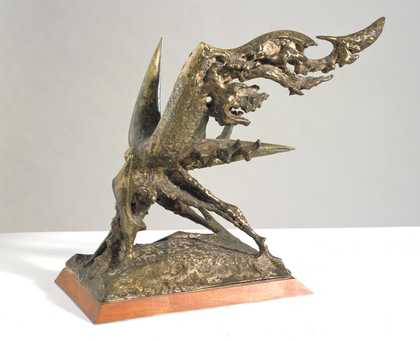
Fig.1
Theodore Roszak
The Unknown Political Prisoner (Defiant and Triumphant) 1952
Steel
371 x 476 x 229 mm
Tate N06163
© Theodore Roszak/VAGA, New York and DACS, London 2018
When Theodore Roszak created his maquette of The Unknown Political Prisoner (Defiant and Triumphant) in 1952 (fig.1) the artist had no prior experience with public commissions or, for that matter, with what could be considered categorically monumental sculpture. In this regard he was no different than most other vanguard sculptors of his generation. The traditional monument, with its associations of heroism, nationalism, and timelessness seemed to many artists and intellectuals of the period inadequate to the task of expressing the existential trauma and complex political and social aftermath of the Second World War. In a lecture delivered the same year that Roszak’s model was submitted to the London competition, Robert Oppenheimer, the scientist most closely associated with the development of the atomic bomb, would delineate the uncertain fortune for the cultural values commonly associated with the monument, stating that ‘perhaps only a malignant end can follow the systematic belief that all communities are one community; that all truth is one truth; that all experience is compatible with all other; that total knowledge is possible; that all that is potential can exist as actual’.1
As the public became increasingly aware of the extent of the war’s horrors, and in particular the realisation that civilisation was capable of unparalleled destruction – and notably self-destruction – the venerable ideals traditionally invested in the monument no longer seemed credible. In particular, it could be argued that the monument’s principal function of preserving memory into a limitless future collapsed as the future of the world itself became endangered by new technologies of destruction. Moreover, and perhaps even more importantly for many artists working in the United States and Allied Europe, the monument’s typically figurative morphology and conspicuous allusions to classical statuary appeared adversely archaic if not malign because of its invocation by many fascist and totalitarian governments at the time.2
Yet the end of the Second World War, like the end of all wars, instigated a desire for various commemorative projects. As the prospectus announcing the sculptural competition for the monument to the unknown political prisoner stated, there was still a demand for more conventional forms of monumental sculpture which would be able to convey ‘universal significance’.3 Yet as the list of finalists selected by the jury demonstrated, it would be a distinctly abstract idiom which was deemed most apposite for expressing the ‘universal significance’ of the monument’s subject.4 For example, among the eleven American nominees whose work was chosen to represent the United States in the international competition, all but one of them submitted a non-objective sculpture and among the abstract works, welded metal was the dominant creative process.5 Welded metal, with its dual associations of industrial production and fiery demolition, would serve as an ideal medium for a monument in a world in which historical continuity, both past and future, was imperiled by the ostensible progress of civilisation.
Roszak was among a group of prominent sculptors in the United States such as Herbert Ferber, David Hare, Ibram Lassaw, Seymour Lipton and David Smith who utilised the welding torch to simultaneously figure the violence that was increasingly associated with industrial technology in the post-war years – especially the relationship between welded metal and aeroplanes – and the liquid and primitivist forms produced by molten metal, producing a foil to what was often seen as the dehumanising repetitiveness of modern society. Indeed, Roszak himself recognised this primeval power of the welding process, describing how when molten steel pools and drips it ‘take[s] on a kind of shape and form right under your eyes that is almost like the cauldron that must be inside the earth itself’.6
The relatively new sculptural technique of direct metal welding, first developed by the Spanish artists Julio González and Pablo Picasso in the late 1920s, would provide an effective means of producing three-dimensional objects whose imposing material presence and oftentimes large scale transposed the traditional semblance of the monument into a new sculptural idiom that could speak to the new cultural landscape bequeathed by the war.7 If the figure of the unknown political prisoner sought to allegorise the freedom for which the war was fought, the direct metal welding process, by providing a sculptural analogue to the gestural brushstroke of the action painter, served as the ideal means to celebrate such individual liberty while darkly intimating the means and costs by which such freedom was propagated and protected.
While the direct welding technique, according to the art historian Robert Goldwater, freed the artist ‘of the expense and cumbersome materials of the traditional methods, with their dependence on expert assistance’, it also aligned their practices with some of the most powerful industrial and distinctly militaristic forces operating at the time.8 Many of the leading sculptors working in the United States in the years following the Second World War not only used the welding torch as their primary instrument but developed their technical skills while contributing to the military effort in one way or another. David Smith, although past the age limit for war duty (he was thirty-seven when the war started) nonetheless was, according to an autobiographical sketch, ‘rated by army ordinance as a 1st class armor plate welder’ of tank frames during the war.9 Similarly, Ibram Lassaw learned to weld during his stint in the army, and Roszak, already an accomplished artist during the 1930s, spent most of the years during the war working at the Brewster Aircraft Corporation and teaching aircraft mechanics at Steven Institute of Technology in New Jersey.10
The welding torch fundamentally transformed the practice of sculpture, allowing the artist to largely work alone in the studio, becoming an existential hero (again like the fabled action painter) who could reconnect with primal drives and forces that more complicated and refined sculptural methods such as carving and casting impeded. For painters and sculptors alike, this summoning of what was seen to be an unbridled and oftentimes violent primitivism could both express the shocking barbarism of the war while simultaneously stage a resistance to the dreaded conformism of an industrialised or totalitarian society.11 Yet unlike painting – whose fundamental and arguably inescapable associations with fine art tempered the rhetoric of violence summoned by the drips, slashes, and blurs on the canvas – welded metal seemed to conjoin the power and directness of primitive culture with signs of contemporary technology. As David Smith noted, materials such as steel were favourable because, it ‘possesses little art history. Its associations are primarily of this century. It is structure, movement, progress, suspension, cantilever and at times destruction and brutality’.12 If, as curator William Seitz noted is his account of the new sculpture, the ‘liberation of sculpture from imitation ... opened civilized eyes to the validity and beauty of primitive and prehistoric sculpture’, it also brought signs of the recent industrial world into the rarefied realms of the museum and gallery.13
Roszak would repeatedly explore the conjunction of primeval natural forces and the savagery of modern warfare in his sculpture. In an interview from 1963 the artist described the way the welding torch captured this complex duality of modern society:
It was through industry and technology that you would find the demon that was doing the destruction, and that’s where all of the instruments of modern technology would enter into play, and the easiest one was, of course, the welding method because it indicated two things – welding means to put things together and then, of course, cutting means destroying them, and this instrument had these two properties.14
These primordial allusions are materialised throughout the rough and pitted surface of Roszak’s The Unknown Political Prisoner (Defiant and Triumphant). The jagged and lapidary forms that jut out from the centre of the object allude as much to natural structures like corals and stalactites as they summon some type of prehistoric creature standing against the wind. Indeed, in many of the preparatory drawings for the work the artist included dynamic dashes surrounding the sculpture, which suggest the powerful elemental forces of wind and rain against which the object must contend (fig.2). The general configuration of the sculpture coupled with its trapezoidal pedestal summons the conventional monumental form of a horse and rider, designating the four triangular formations that rise from the base as limbs of some primitive winged creature. Indeed, the sculpture appears less a triumphant horse and rider than an apocalyptic beast, whose splayed legs, rib cage, tail, and impaled torso, all are notably stripped to the bone, whether due to time or more violent forces.
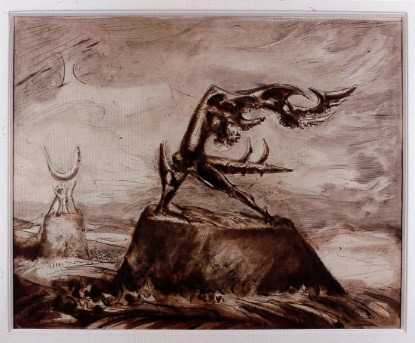
Fig.2
Theodore Roszak
Study for Monument to Unknown Political Prisoner 1951–2
Tate L03772
© Theodore Roszak/VAGA, New York and DACS, London 2018
Photo © Tate
These simulated signs of ruination and what might be described as the work’s anti-evolutionary imagery were in many ways central to Roszak’s mature artistic output, and arguably exemplified in The Unknown Political Prisoner (Defiant and Triumphant). Roszak began his career in the 1930s producing elegant constructivist works such as Airport Sentinel 1932 (fig.3), which celebrated technological invention and precision through the use of modern, non-traditional materials and a resolutely non-objective style. Yet the devastation that such technology unleashed during the Second World War made the artist refute his earlier optimistic attitude towards the subject. In a statement delivered at a symposium dedicated to ‘The New Sculpture’ which took place at the Museum of Modern Art on 12 February 1952, Roszak would describe his decision to abandon the meticulous and graceful constructivist style of his earlier work, stating that ‘When World War 2 came to an end I already knew that the constructivist gears had shifted, and from my point of view, the whole structure took off! …….. in reverse …….. leaving devastation in its wake’.15
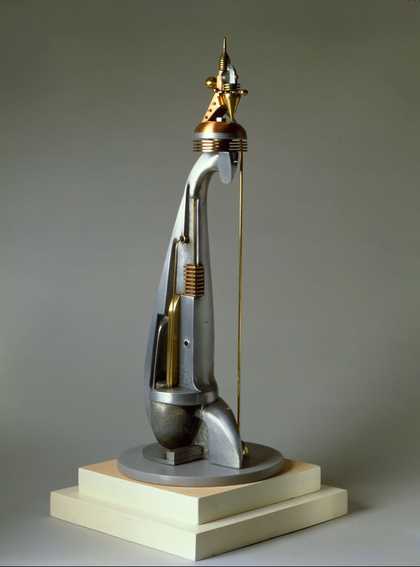
Fig.3
Theodore Roszak
Airport Sentinel 1932
Copper, aluminium, steel and brass
494 x 184 mm
Newark Museum, New Jersey
© The estate of Theodore Roszak
This reverse temporal dynamic, which notably imagined his sculpture looking backwards towards a primeval past rather than forwards to a technologically utopian future, can be seen to reveal the fundamental monumentalism motivating Rozsak’s mature sculptural output. If artists and designers during the post-war period generally eschewed the traditional forms associated with monumental sculpture they did not forgo its underlying multi-directional temporality in which a past event or personage is at once remembered and preserved into an indefinite future. Indeed, the Janus-faced temporal logic of the monument, in which the present and the future survival of the object is linked with a remembered past, would motivate a major strand of post-war sculptural practice in the United States. Yet whereas traditional monumental sculpture imagined its survival into an infinite futurity, preserving the memory of its subject for later generations, the ‘new monuments’ of the post-war era were created for an uncertain future in which the question of the remembrance of the past seemed less crucial than the present survival of humanity. The liquefied metal alloy that constituted Roszak’s monumentalist sculpture was able to simultaneously summon a prehistoric state of nature prior to human habitation, as well as an imagined future in which humankind had annihilated itself and all that remains is a ruinous landscape. The work becomes what cultural historian Johannes von Moltke has termed a ‘proleptic ruin’, anticipating the very destruction figured on their surfaces.16 As such it could be argued that Roszak’s proposal for a monument devoted to the unknown political prisoner, like a great deal of his sculpture from the post-war period, is a monument to a fatal future, one that, on a more optimistic note, might be staved off through its frightening, possibly even apotropaic powers.
Critics in fact recognised these prophetic associations in Roszak’s sculpture. This sentiment was dramatically expressed in a twelve-page colour spread dedicated to the ‘hair-raising’ and ‘upsetting’ new sculpture published in the popular US picture magazine Look in 1950. Artists like Roszak were described in this issue as sensing ‘the struggle of mammoth forces in the modern world, with man shrinking in the total reckoning’, while their sculptures were described as containing ‘shapes suggesting life that might have been on earth before man and might be tough enough to survive him’.17 Other writers also emphasised this double temporality in Roszak’s art, noting its ‘timeless quality’, which provides both ‘echoes of a remote past and harbingers of the future’, and identifying ‘the image of the phoenix’, in which ‘the sense of something quite beautiful and enchanted, something of powerful grace magically evolving out of the ashes of destruction and degeneration’.18 Another writer reviewing the artist’s exhibition at the Los Angeles County Museum of Art in 1957, in which Tate’s work was included, made the artist’s apocalyptic imagination explicit, opining that ‘It may be that fear is so endemic in this nuclear age that it is bound to outweigh man’s nobler traits as material for art. But if these latter again assert themselves in art, as they have in other terrifying time, one may wonder just how horrendous creations such as Roszak’s will look to people of that hoped-for day’.19
These associations of future dereliction, rendered by the effects of the welding torch, would in themselves summon a significant facet of monumentalism as described by the art historian Alois Riegl in a significant essay on the subject written in 1903. Noting the difference between what he calls ‘deliberate monuments’ produced to commemorate certain events, and ‘artistic or historical monuments’, whose significance is an effect of their sheer persistence across time and space, Riegl describes how signs of natural dilapidation become valued as signalling what he calls the object’s ‘age value’ (its public estimation based on its historical longevity).20 Yet while the majority of such monuments are valued because these signs of wear and tear suggest a ‘calm, lawful continuity’, Roszak’s monument, with its jagged edges and mottled surface, suggests instead ‘sudden, violent destruction’, offering its pubic a vision of historical instability and in turn, a new paradigm for monumentality which, arguably, would be explored more overtly by artists in the 1960s such as Robert Smithson and Claes Oldenburg.21
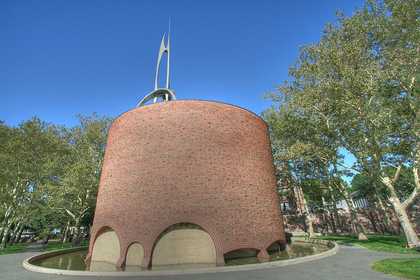
Fig.4
Massachusetts Institute of Technology Chapel, with a bell tower designed by Roszak in 1955
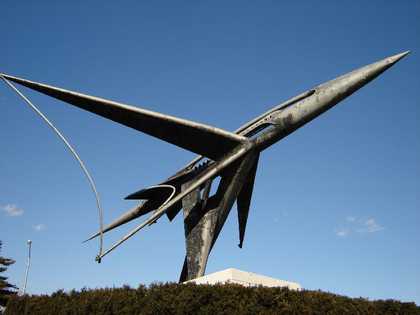
Fig.5
Theodore Roszak
Forms in Transit 1964
Aluminium and steel tubes and sheet metal
Sculpture: 3658 x 4267 x 9144 mm
Flushing Meadows Corona Park, New York
Despite the notable morbidity and pessimism of Roszak’s version of monumentalism as expressed in his maquette for The Unknown Political Prisoner (Defiant and Triumphant), the work no doubt spoke to a prevailing cultural outlook in the post-war period. The success of this model is evinced in the increasing number of monumental commissions Roszak would receive in the years after creating his maquette. Major projects include public sculptures for the Massachusetts Institute of Technology (fig.4), the American Embassy in London, and the Federal Court House in New York City. In 1964 Roszak would serve as a member of the commission to select the design for a memorial to John F. Kennedy and produce a large sculpture for the World’s Fair Exhibition in New York (fig.5). These later commissions, it could be argued, only make explicit how the logic of the monument deeply informed the artist’s entire oeuvre as well as that of many of his contemporaries. Combining the fantasy of archaeological dereliction with imagery that would be at home in the realms of post-war science fiction, artists like Roszak would produce some of the most overt – and occasionally melodramatically hysterical – expressions of both the fear and expectancy engendered by mankind’s relationship to technology in the post-war years.
